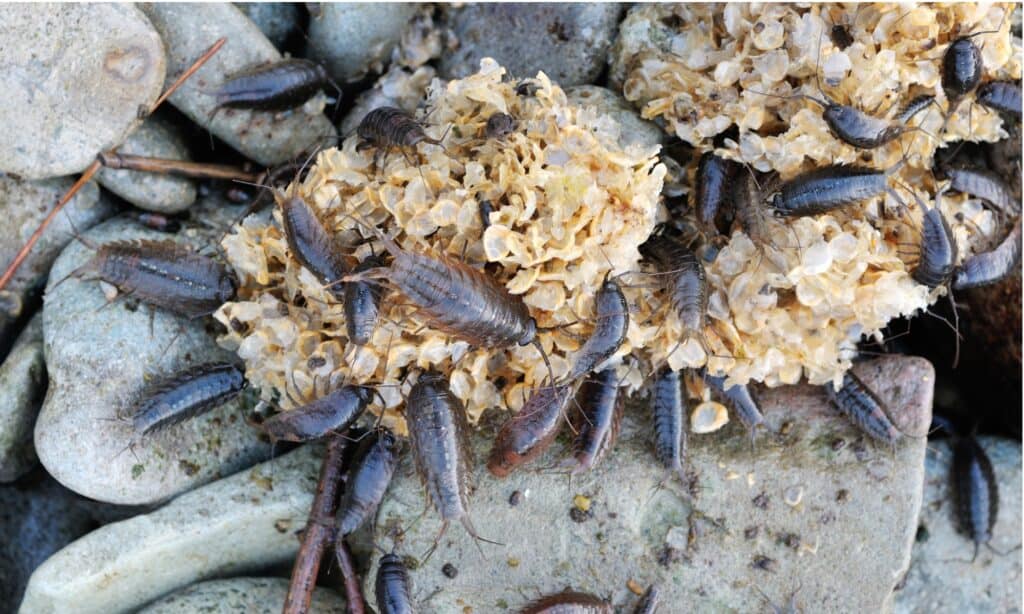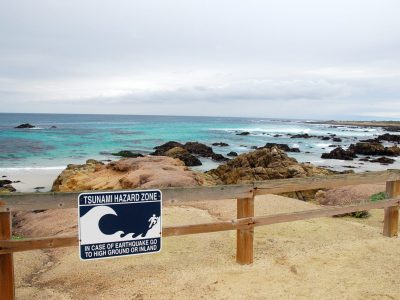Sea Roach
Ligia exotica
They breathe through gills but live on land
Advertisement
Sea Roach Scientific Classification
- Kingdom
- Animalia
- Phylum
- Arthropoda
- Class
- Malacostraca
- Order
- Isopoda
- Family
- Ligiidae
- Genus
- Ligia
- Scientific Name
- Ligia exotica
Read our Complete Guide to Classification of Animals.
Sea Roach Conservation Status
Sea Roach Facts
- Name Of Young
- Baby sea roach or juvenile
- Group Behavior
- Solitary
- Fun Fact
- They breathe through gills but live on land
- Estimated Population Size
- Unknown
- Biggest Threat
- Water pollution
- Most Distinctive Feature
- Segmented shell
- Other Name(s)
- Sea slater, wharf roach
- Gestation Period
- 28 days
- Litter Size
- Average of 80
- Habitat
- Around waterlines under rocks, near piers
- Predators
- Fish, birds
- Diet
- Omnivore
- Favorite Food
- Decaying vegetation, dead fish
- Type
- Insect
- Common Name
- Sea roach
- Location
- Coasts of Ireland, England, United States
Sea Roach Physical Characteristics
- Color
- Grey
- Skin Type
- Shell
- Lifespan
- 2.5 years
- Weight
- Less than one ounce
- Length
- 1 inch
- Age of Sexual Maturity
- 1 year
- Age of Weaning
- At birth
View all of the Sea Roach images!
The sea roach is a crustacean with a gray, segmented shell.
Though they breathe through gills, these tiny creatures live on land. They have fourteen legs, two short antennae, and two long antennae. Sea roaches play an important part in the ecosystem by eating decomposing plants, rotting fish, algae, and more. They are found in coastal areas.
5 Incredible Sea Roach Facts!
- Sea roaches are sometimes mistaken for shrimp because of a similarity in appearance.
- Though they live on land, they must keep their gills wet in order to breathe.
- This crustacean is sometimes called a wharf roach because many live around piers.
- They are edible, but are known to have a very bitter taste!
- These creatures take cover beneath rocks during the day and come out at night.
Sea Roach Species, Types, and Scientific Name
Ligia exotica is the scientific name of a sea roach. The Latin word Ligia is this crustacean’s genus and exotica translates to the word exotic. It’s in the Ligiidae family and the class Malacostraca. A sea roach is an isopod and a crustacean.
Other species which are also referred to as sea roaches include:
- The sea slater-Ligia oceania: A member of the genus Ligia, the sea slater is capable of growing to 1.2 inches in length and prefers colder regions. This in addition to its green or gray coloring differentiates it from the sea cockroach Ligia exotica, which can grow as long as 1.6 inches, tolerate both temperate and subtropical climates, and is dark gray in color.
- The giant isopod or giant sea roach: Unlike the other two which are members of the genus Ligia, this creature belongs to the genus Bathynomus. It is capable of growing up to 6 inches and the largest member of the genus, the Bathynomus giganteus is capable of growing as large as 14.2 inches and has even been known to grow to 20 inches.
Appearance: How to Identify a Sea Roach
An adult sea roach is one inch long with a flat, segmented, gray shell. It has fourteen legs and two pairs of antennae. They have two dark eyes on the front section of their body. A baby sea roach measures about half the length of an adult’s body. Due to their tiny size, baby sea roaches are even more vulnerable to being eaten by birds or fish.
Sea roaches have been compared to many other types of tiny animals. For example, they earned their name due to their likeness to cockroaches. They’ve also been compared to pill bugs because of their segmented dark shell. In addition, both shrimp and sea roaches have segmented bodies and long antennae. But shrimp live in the water while sea roaches live on land.
Another crustacean called a giant isopod is also similar in appearance to a sea roach. Both creatures are isopods, but the giant isopod is one of the largest measuring just over one and a half feet in length!
Though they live on land, sea roaches must stay near the water so they can keep their gills wet in order to breathe. Consequently, they’re found living under rocks and other debris in coastal areas as well as around piers. While sea roaches have to keep their gills wet, they don’t swim in bays or oceans. In fact, a sea roach that tries to swim would likely drown. They go into very shallow pools to keep their gills wet enough to breathe.
Not surprisingly, sea roaches are easy prey because of their small size. But, they do have a few defenses against their predators. For one, they have a bitter taste that deters some predators from eating them. Plus, their dark shell helps them to blend in and hide within their habitat. Remember these small creatures are active at night which means they are even more difficult for a predator to spot. Sea roaches move very quickly on their fourteen legs and can potentially escape birds, fish, and other threats.
The sea roach and sea slater can be found alone or gathered in groups beneath rocks, piles of sticks, and other debris. A group of sea roaches is called an intrusion.

©iStock.com/odyphoto
Habitat: Where to Find Sea Roaches
Sea roaches live in coastal areas in a variety of places. They are found in temperate waters on the coast of Ireland, England, and the coasts of the United States. Though they don’t live in the water, they need it to keep their gills wet so they are able to take in oxygen.
These crustaceans live under rocks on a shore or beach. They are also found around piers where they have easy access to water. Someone walking on a beach may see sea roaches crawling on a dead fish or a pile of algae or seaweed washed up from a bay. Or, these animals may be seen climbing around in the sand at the base of a pier or wharf in search of dead or decaying items deposited on land when the tide moves out.
Diet: What Do Sea Roaches Eat?
Sea roaches eat dead organisms and plant material in the environment. A group of sea roaches on a beach can eat tons of plant matter and dead aquatic animals.
What does a sea roach eat?
Specifically, a sea roach or sea slater eats dead fish, decaying seaweed, algae, and other carrion that ends up on a shoreline. When sea roaches and other scavengers eat decaying material, it makes way for new plant life to emerge. So, you see how important sea roaches are to the health of the ecosystem.
What eats sea roaches?
Birds and fish eat sea cockroaches. Though they are not edible to some animals, there are large birds and fish that swallow them whole without a problem.
View all 293 animals that start with SSea Roach FAQs (Frequently Asked Questions)
Are sea roaches dangerous?
No, this crustacean doesn’t bite humans and is no threat to them. In fact, when a sea roach encounters a human, it quickly crawls away in search of a hiding place. But, if a predator takes a bite out of a sea roach, it may be surprised by the bitter taste of this crustacean!
How many legs does a sea roach have?
A sea roach has 14 legs. It has seven on one side of its body and seven on the other.
How do you identify a sea roach?
A sea roach has a flat, oval shell. Its shell is dark gray and segmented by a series of horizontal lines. They are one inch or less in length and weigh less than one ounce. These creatures have four antennae: two short and two long. Its long pair of antennae can measure two-thirds the length of this crustacean’s body. It has two black eyes.
How do you get rid of sea roaches?
Sea roaches live on beaches and rocky coastlines. They aren’t known to invade a residence like a cockroach or an ant.
Is a sea roach really a roach?
No. They are isopods and crustaceans. They are called sea roach for a couple of reasons. For one, their dark shell, long legs, and long antenna make them look like a typical roach (cockroach). Secondly, both sea roaches and cockroaches eat decaying material in the environment. But remember, while cockroaches are found in homes and elsewhere on land, a sea roach has to live near the water in order to keep its gills moist so it can breathe.
Are crayfish sea roaches?
No, they are two types of animals. However, crayfish and sea roaches are both crustaceans. They are also similar in appearance with a hard shell covering, antennae, and long thin legs. These commonalities make it easy to think they are the same animal. As a note, one difference between a crayfish and a sea roach is a crayfish can bite and grab onto prey and even a person’s finger with its claws. A crawfish bite or pinch may hurt a little bit depending on the size of the crustacean.
Are shrimp really the roaches of the sea?
Sea roaches and shrimp are both known as the roaches of the sea. They are both crustaceans that eat decaying plants, algae, and mold.
Though they are similar in appearance, it’s really their eating habits that have given them this unflattering description. But keep in mind shrimp are considered edible and very tasty, while sea roaches are not considered a delicacy.
Thank you for reading! Have some feedback for us? Contact the AZ Animals editorial team.
Sources
- Texas A&M, Available here: https://landscapeipm.tamu.edu/what-is-ipm/ipm-concepts/pest-identification/good-bug-bad-bug/neither/scud/
- Texas A&M, Available here: https://citybugs.tamu.edu/factsheets/landscape/veggie/ent-1006/
- Wikipedia, Available here: https://en.wikipedia.org/wiki/Bathynomus_giganteus
- Futurity, Available here: https://www.futurity.org/deep-sea-giant-isopod-bathynomus-raksasa-2422042/
- Hampshire & Isle of Wight Wildlife Trust, Available here: https://www.hiwwt.org.uk/wildlife-explorer/marine/crustaceans/sea-slater
- Think Port, Available here: https://www.thinkport.org/bayville/printables/sea_roaches.pdf
- Wikipedia, Available here: https://en.wikipedia.org/wiki/Crayfish

















